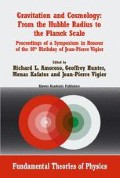Abstract
The idea that a ‘magnetized’ charged particle in interaction with ‘resonant’ photons operates from an energy level to another higher one by a stochastic acceleration effect suggests that such effects may represent a phenomenological physical mechanism which explains how an electron jumps to higher atomic orbits when it absorbs resonant photons. If we increase the number of iterations of the corresponding nonlinear system of equations, we obtain a Bohr image of an atom. Such (quantum-transition) jumps, their duration and physical mechanism have never been explained by the quantum theory of atoms. We thus offer through such a cascade of chaotic kicked (stochastic acceleration) effects a physical explanation of the quantum model of absorption of energy by an atom. The proposed equations can model a circuit biased with a traveling electromagnetic wave. Such a circuit can also simulate a stochastic acceleration and a chaotic atom.
Access this chapter
Tax calculation will be finalised at checkout
Purchases are for personal use only
Preview
Unable to display preview. Download preview PDF.
References
Steiner, F.: Quantum Chaos, Invited contribution to the Fetschrift Universität Hamburg 1994: Schlaglichter der Forschung zum 75. Jahrestag (Ed.R. Ansorge) published on the occasion of the 75th anniversary of the University of Hamburg, Dietrich Reimer Verlag, Hamburg 1994, pp. 542–564.
Manfredi, V. R. and Salasnich, L.: Different Facets of Chaos in Quantum Mechanics, Int. J. Mod. Phys. B, 13(18) (1999), 2343–2360.
Aurich, R., Bolte, J. and Steiner, F.: Universal Signatures of Quantum Chaos, DESY Report 94-024, February 1994.
Berry, M. V.: in Dynamical Chaos, The Royal Society, London, 1987.
Haggerty, M. R.: Semiclassical quantization in a smooth potential using Bogomolny’s quantum surface of section, PhD Thesis, Massachusetts Institute of Technology, 1994.
Gutzwiller, M. C.: Energy Spectrum According to Classical Mechanics, J. Math. Phys. 11 1970, 1791–1806.
Gutzwiller, M. C.: Periodic Orbits & Classical Quantization Conditions, J. Math. Phys. 12 (1971), 343–358.
Gutzwiller, M. C.: Chaos in Classical and Quantum Mechanics, Springer, New York, 1990.
Feynman, R. P.: Space-Time Approach to Non-Relativistic Quantum Mechanics, Rev. Mod. Phys. 20 (1948), 367–387.
Feynman, R. P. and Hibbs, A. R. Quantum Mechanics and Path Integrals. McGraw-Hill, New York, 1965.
Cvitanović, P.: Classical and Quantum Chaos, version 6.0.2, Feb 2, 2000, printed April 7, 2000 (www.nbi.dk/ChaosBook/).
Argyris, J. Ciubotariu, C.: A new physical effect modelled by an Ikeda map depending on a monotonically time-varying parameter, Int. J. Bif. Chaos 9 (1999), 1111–1120.
Butcher, J. C., The Numerical Solution of Ordinary Differential Equations. Wiley, Chichester, 1987.
Koonin, S. E., Computational Physics. Benjamin Cummings, Menlo Park, 1986, Chap. 4.
Press, W. H., Flannery, B. P., Teukolski, S. A. and Vetterling, W. T. Numerical Recipes. Cambridge University Press, Cambridge, 1986.
Pound, R. V. and Rebka, G. A.: Apparent weight of photons, Phys. Rev. Lett. 4 (1960), 337–341.
Pound, R. V. and Snider, J. L.: Effect of gravity on nuclear resonance, Phys. Rev. Lett. 13 (1964), 539–540.
Pound, R. V. and Snider, J. L.: Effect of gravity on gamma radiation, Phys. Rev. B 40 (1965), 783–803.
Author information
Authors and Affiliations
Editor information
Editors and Affiliations
Rights and permissions
Copyright information
© 2002 Kluwer Academic Publishers
About this paper
Cite this paper
Ciubotariu, C., Stancu, V., Ciubotariu, C. (2002). A Chaotic-Stochastic Model of an Atom. In: Amoroso, R.L., Hunter, G., Kafatos, M., Vigier, JP. (eds) Gravitation and Cosmology: From the Hubble Radius to the Planck Scale. Fundamental Theories of Physics, vol 126. Springer, Dordrecht. https://doi.org/10.1007/0-306-48052-2_35
Download citation
DOI: https://doi.org/10.1007/0-306-48052-2_35
Publisher Name: Springer, Dordrecht
Print ISBN: 978-1-4020-0885-6
Online ISBN: 978-0-306-48052-2
eBook Packages: Springer Book Archive

